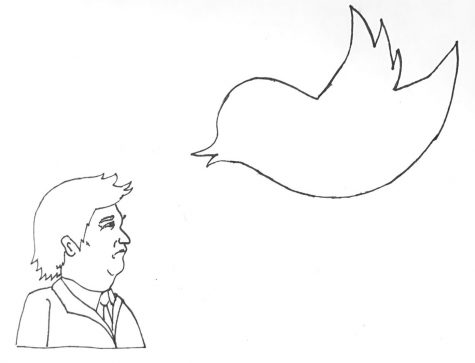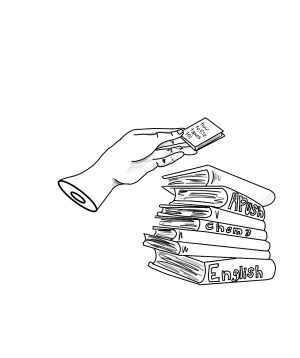@realDonaldTrump Tweeted: nothing, he’s banned
January 27, 2021
Social media: the relatively new and boundless world filled with entertainment, opinions, news and politics. An important rule about the internet is that what is posted is immortalized, so as an individual’s follower count rises, the amount of influence they hold increases along with it. What they say or post is sometimes hailed as law and therefore the permanence of those ones and zeros start leading to dire consequences. This requires that people like former President Donald Trump, who had upwards of 88 million Twitter followers, post responsibly, evaluating the factuality and composure of their online voice. However, as seen by his track record of inaccurate Tweets and posts encouraging and then condoning early January’s Capitol riot, Trump has failed to act accordingly. In response, the Twitter corporation took significant, yet appropriate, action by banning Trump’s account effective Jan. 8, 2021.
To date, Trump has been removed from multiple social media platforms, including Facebook, Instagram and TikTok, a platform he once diligently dedicated himself to banning in America. Twitter is one of the more striking names on this list because Trump was highly active on the platform and had amassed quite a sizable follower count, which outweighed that of his Instagram account by more than threefold. From numerous speculations concerning actor Robert Pattinson’s love life to claims of a stolen election, Trump has proven himself to be quite the relentless Tweeter. Although his posts were abundant, they lacked accuracy. According to Bethany Dawson, a reporter for the Independent, one-third of his Tweets in the week following Election Day were flagged as containing false or misleading and disputed content.
If only disinformation were the sole repercussion of Trump’s Twitter presence. In an official statement about Trump’s ban from the app released on Jan. 8, Twitter imparted that Trump’s latest Tweets may have caused more than just the spread of misinformation. The statement declared that his posts went against their Glorification of Violence policy and was the reason for his censorship. Specifically, the issue lay not only in the idolization of the attack on the Capitol but were also worried that the Tweets could inspire similar events in the future.

Trump’s latest impeachment in the House of Representatives proposes that he can be tied much closer to the riot at the Capitol than what Twitter’s statement suggests. He was deemed culpable for encouraging those who stormed the Capitol and was charged with “incitement of insurrection” by the House, connecting him more directly to the uprising.
A timeline of events leading up to and during the assault on the Capitol made by Just Security, an organization backed by New York University School of Law, reveals some of his most provocative actions, many of which include his Tweets. On Dec. 19, 2020, Trump stated on Twitter, “Big protest in D.C. on January 6th. Be there, will be wild!” This was followed on Dec. 27, 2020 with, “See you in Washington, D.C., on January 6th. Don’t miss it. Information to follow.” Finally, on Jan. 6, 2021 at 6:01 p.m., the day that the Capitol was breached by protestors, he tweeted, “These are the things and events that happen when a sacred landslide election victory is so unceremoniously & viciously stripped away from great patriots who have been badly & unfairly treated for so long. Go home with love & in peace. Remember this day forever!”
Trump’s fallacy-filled and heady Tweets pose a new kind of peril: disinformation and aggression gone viral, a danger in which only booting him from the app could solve.
Nevertheless, a valid concern arises from these events, the power of “Big Tech,” the major companies of the information technology world. Specifically, many find themselves questioning how much power is too much. Many took Twitter’s response of kicking Trump off the platform as a display of an unwieldy amount of control.
Senator Elizabeth Warren is especially wary of Big Tech, aiming to one day break it up. Warren maintains the assertion that Big Tech holds too much power in nearly all aspects of life. Trump’s permanent suspension is simply another example of Big Tech wielding their strength and acting on their own accord. During her presidential campaign for President in 2019, Warren maintained her assertion about Big Tech’s problems, stating,
“Today’s big tech companies have too much power — too much power over our economy, our society and our democracy.”
Consumer Reports discovered through a survey that three out of four Americans are uncomfortable with Big Tech’s power over the general public. Additionally, to others, Twitter’s silencing of Trump seems almost like “unAmerican” censorship.
This argument can only be taken so far, though. The same Consumer Reports survey conveyed that six in 10 Americans were for “reducing harmful conduct” when it comes to Big Tech. In that respect, Twitter had set up its own guidelines and when Trump didn’t follow them, he and his “harmful conduct” were swiftly removed from the platform. Additionally, the same rules do not always apply to both people and corporations. Thus, the Constitution is also not arguable in this instance of censorship. It is within Twitter’s realm of legality to ban Trump because it is a corporation, therefore the First Amendment cannot be argued, as private companies are immune.
All in all, removing Trump from Twitter was a necessary and welcomed action from Twitter. The former president’s account only further fueled his most extreme supporters and spread copious amounts of falsehoods to a large audience. Although Twitter’s slightly threatening amount of power in the tech industry was made clear, it is better than the continued threat of Trump’s largely unchecked Twitter presence of the past.







